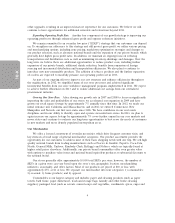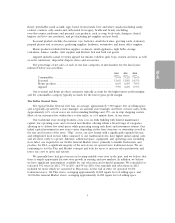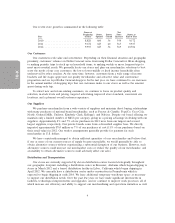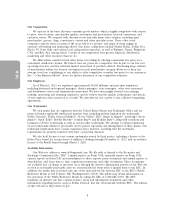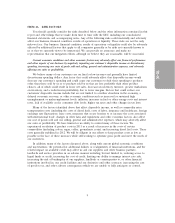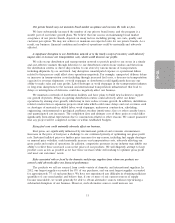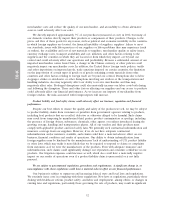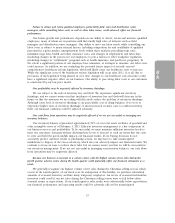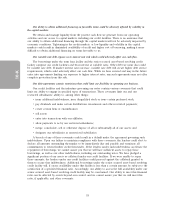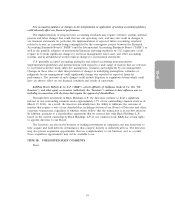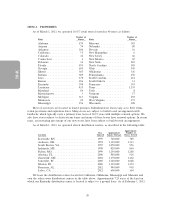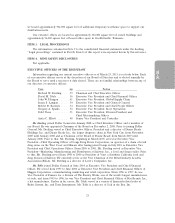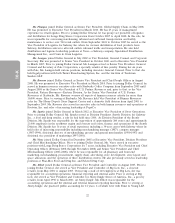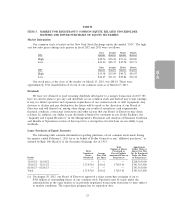Dollar General 2012 Annual Report Download - page 93
Download and view the complete annual report
Please find page 93 of the 2012 Dollar General annual report below. You can navigate through the pages in the report by either clicking on the pages listed below, or by using the keyword search tool below to find specific information within the annual report.
10-K
Many of our new stores will be located in areas where we have existing units. Although we have
experience in these markets, increasing the number of locations in these markets may result in
inadvertent over-saturation and temporarily or permanently divert customers and sales from our
existing stores, thereby adversely affecting our overall financial performance.
Natural disasters (whether or not caused by climate change), unusual weather conditions, pandemic
outbreaks, terrorist acts, and global political events could cause permanent or temporary distribution center or
store closures, impair our ability to purchase, receive or replenish inventory, or decrease customer traffic, all
of which could result in lost sales and otherwise adversely affect our financial performance.
The occurrence of one or more natural disasters, such as hurricanes, fires, floods and earthquakes,
unusual weather conditions, pandemic outbreaks, terrorist acts or disruptive global political events, such
as civil unrest in countries in which our suppliers are located, or similar disruptions could adversely
affect our operations and financial performance. To the extent these events result in the closure of one
or more of our distribution centers, a significant number of stores, or our corporate headquarters or
impact one or more of our key suppliers, our operations and financial performance could be materially
adversely affected through an inability to make deliveries or provide other support functions to our
stores and through lost sales. In addition, these events could result in increases in fuel (or other
energy) prices or a fuel shortage, delays in opening new stores, the temporary lack of an adequate work
force in a market, the temporary or long-term disruption in the supply of products from some domestic
and overseas suppliers, the temporary disruption in the transport of goods from overseas, delay in the
delivery of goods to our distribution centers or stores, the temporary reduction in the availability of
products in our stores and disruption of our utility services or to our information systems. These events
also can have indirect consequences such as increases in the costs of insurance if they result in
significant loss of property or other insurable damage.
Material damage or interruptions to our information systems as a result of external factors, staffing
shortages and unanticipated challenges or difficulties in updating our existing technology or developing or
implementing new technology could have a material adverse effect on our business or results of operations.
We depend on a variety of information technology systems for the efficient functioning of our
business. Such systems are subject to damage or interruption from power outages, computer and
telecommunications failures, computer viruses, security breaches and natural disasters. Damage or
interruption to these systems may require a significant investment to fix or replace them, and we may
suffer interruptions in our operations in the interim. Any material interruptions may have a material
adverse effect on our business or results of operations.
We also rely heavily on our information technology staff. Failure to meet these staffing needs may
negatively affect our ability to fulfill our technology initiatives while continuing to provide maintenance
on existing systems. We rely on certain vendors to maintain and periodically upgrade many of these
systems so that they can continue to support our business. The software programs supporting many of
our systems were licensed to us by independent software developers. The inability of these developers
or us to continue to maintain and upgrade these information systems and software programs would
disrupt or reduce the efficiency of our operations if we were unable to convert to alternate systems in
an efficient and timely manner. In addition, costs and potential problems and interruptions associated
with the implementation of new or upgraded systems and technology or with maintenance or adequate
support of existing systems could also disrupt or reduce the efficiency of our operations.
14


